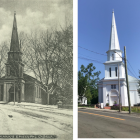Now & Then
New Canaan Now & Then: ABC House
|
Just a short walk down the hill from the New Canaan Museum & Historical Society is 64 Locust Ave or ABC House. This home was built in 1906 by Luther Scofield Knapp, referred to as L.S. Knapp in the photograph. Knapp was a native of Stamford and was born there in 1870. He spent most of his life living in New Canaan as a mason and contractor. He helped to build the First National Bank, which stands next to town hall, along with the Silliman building which stands on the north corner of Main and East Ave. He also helped to construct the last iteration of Center School in 1909. He was perhaps given this contract because he was elected to the School Committee in 1902, 1905, 1908, and 1915. He was also a member of the Board of Burgesses back when downtown New Canaan was a borough. Knapp’s wife Mary Provost, born in 1873, was a lifelong New Canaan resident, and was educated in the Little Red Schoolhouse on Carter Street (now one of the Museum’s historic properties.) The couple and their daughter Rose lived in the house for seventeen years until they moved to 28 Greene Ave. 64 Locust Avenue was then owned by Jennie Ferrera and her husband, Felice. Originally from New York City, Jennie moved to New Canaan in 1910. Jennie and Felice ran a food market that was located in the H.B. Rogers building on Main Street, which is now home to New Canaan Music and Stretch Lab. The couple also owned the building and it seems that Jennie was in charge of renting out the rooms. Various rent ads for the building can be seen in the Advertiser over a number of years all with Jennie’s name as the contact. Jennie also ran an ad in June of 1942 for fireworks she was selling from the market, claiming to be “carrying every type that the government allows.” With Jennie’s death in 1953, the house was then sold to Luigi Colarossi, who remodeled the building as a two family home. Eventually in 1971, he sold the house to Genesis Inc, which was a youth drug prevention program that used the building as its headquarters.




